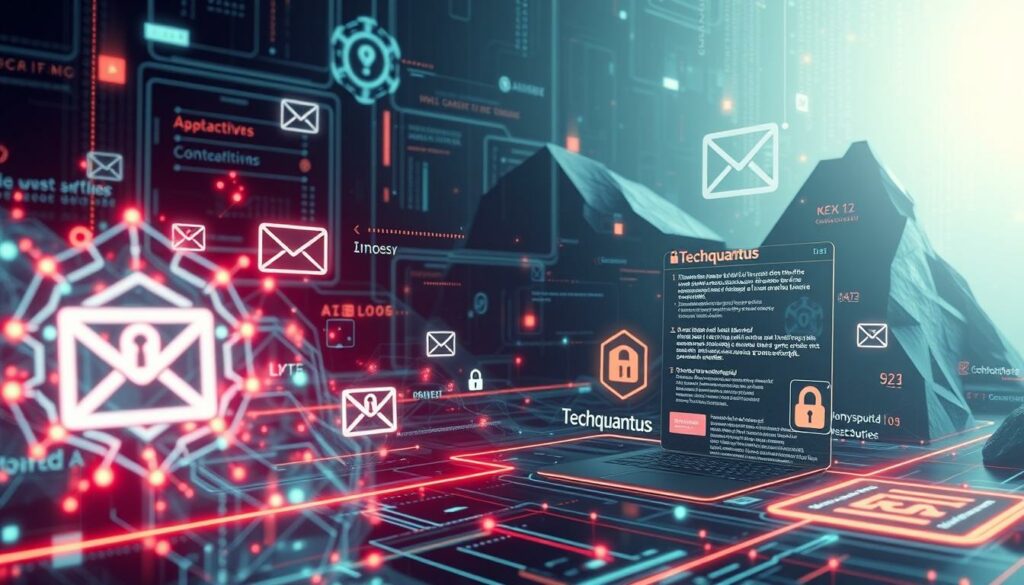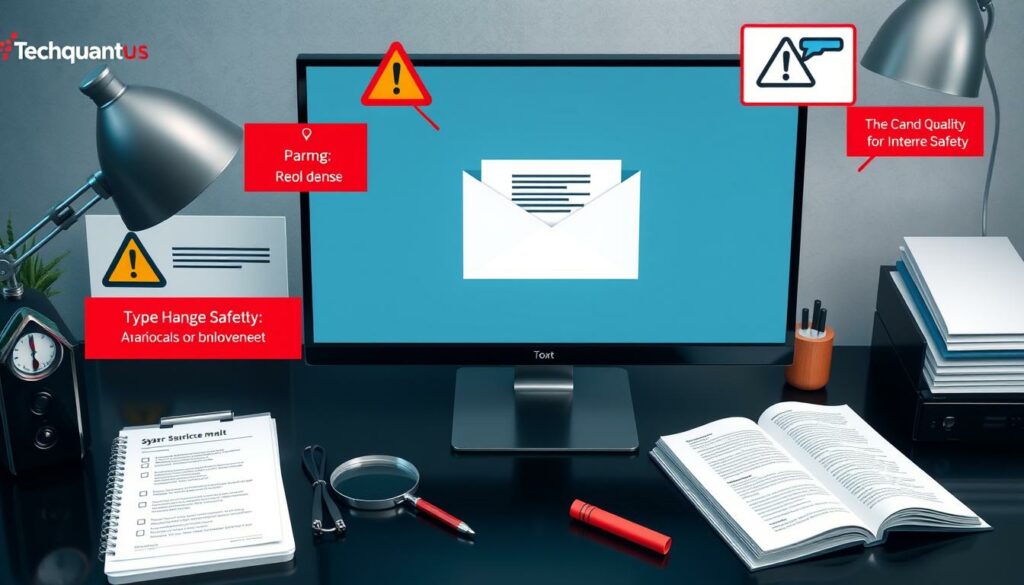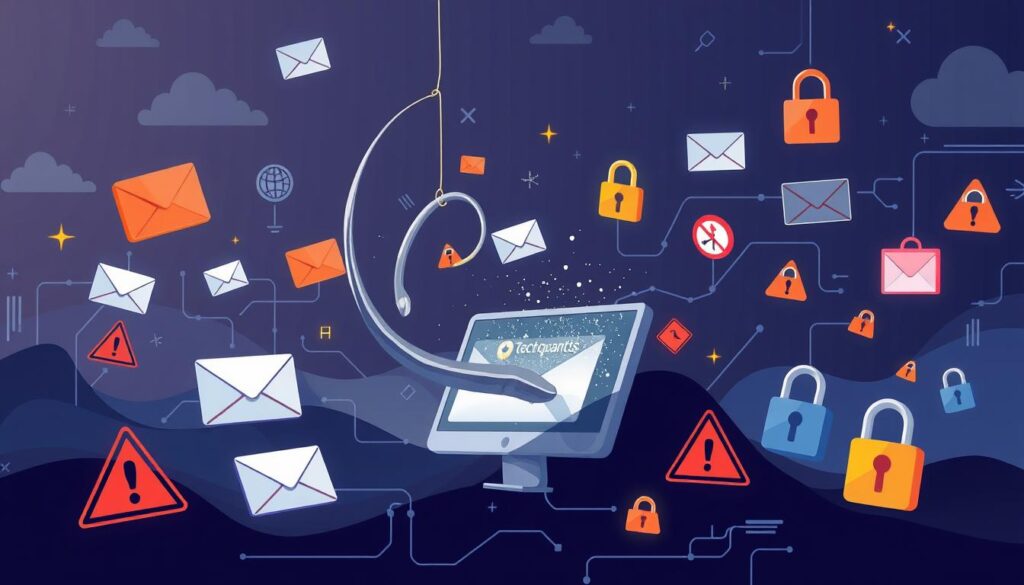Did you know nearly every American gets about 12 fake messages daily through email, text, or social media? This shows how common phishing attacks are today. These scams try to steal your personal info by pretending to be trustworthy. It’s key to know how to spot and stop these attacks to keep your info safe.
With new cyber threats always coming up, it’s important to be proactive with your online safety. Learning how to protect yourself is a must.
Key Takeaways
- Phishing attacks are common, with Americans facing nearly 12 fake messages daily.
- Scammers often pretend to be well-known companies to gain trust.
- AI is now used to make phishing messages seem more real.
- Knowing what phishing looks like is key to avoiding it.
- Strong email security can greatly lower your risk.
- People under stress are often targeted by phishing scams.
Understanding Phishing Attacks
Phishing attacks are a big problem in the world of cybersecurity. They use tricks to get people to share sensitive info. These scams usually come through emails, texts, or social media, making them very common.
Scam emails pretend to be from trusted sources. They try to get you to click on dangerous links or give out your personal info on fake websites. It’s hard to tell real messages from fake ones. Knowing how phishing works helps you spot the warning signs and avoid scams.
Now, there’s even more dangerous malware like ManticoraLoader. It targets Windows systems, steals info like IP addresses, and gets past security. This shows how phishing attacks are always getting more sophisticated.
It’s important to keep up with these new tactics. By learning about phishing, you can better protect yourself and your data. Being aware is key to fighting against phishing and email scams.
Different Types of Phishing Attacks
Phishing attacks come in many forms, each trying to trick you into sharing sensitive info. Knowing about types of phishing can really help protect you from these cybersecurity threats.
Spear phishing targets specific people by pretending to be someone they know, with messages made just for them. This makes it more likely to succeed by building a fake personal connection. On the other hand, whaling goes after big names, like company leaders. These attacks are often more complex, aiming for big financial gains or sensitive data.
Vishing is another type that uses voice calls to trick victims. Scammers might claim to be from a trusted company, trying to get personal info over the phone. They use fear and urgency to make you act quickly, like sharing sensitive details.
With so many online scams out there, staying alert is key. Learning about these different types helps you spot and stop potential threats. Here’s a table to help you understand the various phishing tactics:
| Type of Phishing | Description | Targets |
|---|---|---|
| Spear Phishing | Personalized messages aimed at specific individuals | Individuals, employees |
| Whaling | Attacks targeting high-profile individuals | Executives, directors |
| Vishing | Voice phishing, often via phone scams | General public, specific corporations |
Common Signs of Phishing Emails
Learning to spot phishing emails boosts your email security and cybersecurity awareness. Knowing the common warning signs helps you dodge these tricky scams. It’s key to recognize these clues to keep your private info safe from hackers.
Unexpected Requests for Personal Information
One big red flag is when you get asked for your personal or financial info out of the blue. Real companies don’t usually ask for this stuff via email. If an email wants your passwords, credit card numbers, or social security number, be very careful. Always check who sent it before sharing any info.
Generic Greetings and Poor Grammar
Phishing emails often don’t address you by name. If an email just says “Dear customer” instead of your name, it might be a scam. Also, they often have bad grammar, spelling errors, or weird sentences. These mistakes mean the email is likely a fake. Being alert to these signs can help keep your email security strong. For tips on keeping your personal info safe, check out this resource.
How AI is Changing the Phishing Landscape
AI has changed how cybercriminals work in phishing attacks. It lets them make phishing messages that look real. This makes it hard for people to tell real messages from digital scams. Knowing how AI works in this area helps us fight back.
AI-Powered Phishing and Its Risks
AI in phishing is a big risk because it helps make fake content easily. Researchers at Northwestern University found AI can make fake images of people 70% of the time. This shows how hard it is for security teams to tell real from fake.
AI makes social engineering tricks more convincing. This makes old ways of spotting digital scams less useful.
Identifying AI-Generated Scams
Finding AI-generated scams is tough. A study at the University of Notre Dame showed people can spot AI bots only 42% of the time. This shows we need better ways to fight cyber threats.
There are new tools to fight fake news from social media bots. These tools check if content is real, helping us avoid digital scams.

The Role of Email Security in Preventing Phishing Attacks
In today’s digital world, strong email security is key in fighting phishing attacks. Cybercriminals often use email to send scams, so it’s vital for companies to have good phishing prevention plans.
Using multi-factor authentication (MFA) is a big step. This cybersecurity measure adds more protection by asking for more than just a password. With MFA, the risk of hackers getting into your sensitive info goes down a lot.
Email filtering is also crucial for email security. It helps spot and block phishing emails before they get to you. By keeping out bad emails, you protect your employees from clicking on dangerous links or sharing personal details.
Teaching your team about phishing attacks is also key. Training them to spot suspicious emails helps them protect your system. It’s important to make everyone aware, as even the best cybersecurity measures can fail without alert users.
Finally, companies need to have strong email security plans and stay alert. With these steps, you can make phishing attacks less likely to work, keeping your data and reputation safe.
Best Practices to Spot Phishing Attacks
It’s key to know how to spot phishing to boost your online safety. By using best practices, you can catch and stop these threats. Paying close attention to emails and links is crucial.
Verify Email Senders
Always check the sender’s email address. Make sure it matches the official domains you’re expecting. Criminals often fake email addresses to look real. This simple check is a top way to keep your info safe.
Look for Misspelled URLs
Look at URLs for any misspellings or strange characters. Real companies usually have consistent names and domains. Phishing sites often have small spelling mistakes. Checking these URLs helps protect you from scams.

| Practice | Description |
|---|---|
| Verify Email Addresses | Check for consistency with known domains, ensuring authenticity. |
| Examine URLs | Look for misspellings and unusual characters that indicate fakes. |
| Be Cautious with Links | Avoid clicking on links without verification. |
| Report Suspicious Emails | Notify your IT department or email provider to handle potential threats. |
Learning these strategies will make you better at spotting phishing. It will also make the internet safer for everyone. For more info, check out this article on Generative AI in cybersecurity.
Implementing Strong Cybersecurity Measures
To fight off cyber threats, it’s key for both people and companies to use strong cybersecurity steps. Being proactive in digital security can greatly lower the chance of data theft and protect against phishing attacks.
Using strong, unique passwords is a top way to boost cybersecurity. Don’t reuse passwords and think about using a password manager for safe storage and creation. Keeping your devices and apps updated is also crucial, as updates often fix security holes.
For businesses, regular cybersecurity assessments are a must. These checks spot weak spots in your systems, keeping them safe from new threats. It’s also important to train employees on phishing tactics and defense methods. Educating everyone can make your defense stronger.
Services like Google’s Dark Web Report are key for monitoring your personal info. They alert you if your data has been leaked. This helps you act fast if there’s a breach. Google’s focus on user privacy shows how vital it is to protect our digital info.
Changing passwords often and using different email for private stuff can also help in phishing defense. Adding two-factor authentication gives you an extra shield against hackers.
Strong cybersecurity steps not only protect your data but also build a culture of security awareness. These efforts can greatly reduce the risk of phishing and other cyber threats. For more tips on improving your cybersecurity, check out these valuable resources.
The Importance of User Education
User education is key in fighting phishing attacks. It teaches people how to spot threats, making the whole system safer. Knowing how to stay safe online is crucial for everyone.
Training sessions teach the ins and outs of avoiding phishing. They keep users up-to-date with new tricks used by scammers. The more informed users are, the better they can handle phishing attempts.
| Training Initiative | Impact on Phishing Reporting | Improvement in User Awareness |
|---|---|---|
| Monthly Workshops | 50% increase | 75% improvement |
| Email Simulations | 70% increase | 80% improvement |
| Regular Newsletters | 30% increase | 60% improvement |
Putting a big focus on user education is vital against phishing. With better online safety knowledge, users can move through the digital world safely. This lowers the risk of getting tricked by scams.
Phishing Attacks: How to Report and Mitigate Them
If you find yourself facing a phishing attack, act fast for your online safety. Start by telling the Federal Trade Commission (FTC) or your email provider about the phishing. This helps keep others safe from the same scam.
Here are important steps to follow:
- Change your passwords right away to keep your accounts safe.
- Alert your bank if you think your financial info might be at risk to stop fraud.
- Keep an eye on your accounts for anything odd, which helps you stay secure.
- Use credit monitoring services to watch for any strange activity with your info.
It’s key to have strong online safety steps to avoid future attacks. These include:
- Don’t use public WiFi for important logins
- Be careful with personal info from unknown sources
- Know how to spot and deal with phishing scams
Services like Experian or Google One offer free checks to see if your data is on the dark web. These steps can greatly lower the risk of your data being used without permission.
Conclusion
Phishing attacks are a big threat in our digital world. It’s important to know how these scams work and how to spot them. By being aware and taking steps to protect yourself, you can stop cybercriminals.
These scams have gotten smarter, now targeting things like cryptocurrency. They try to get your login info or make you send money. To stay safe, always check emails and URLs carefully and keep your software updated.
Being proactive with your cybersecurity is key. Joining educational efforts helps keep your info safe in a tough world. Regular checks, reporting odd activities, and working with others are key to fighting phishing attacks.
FAQ
What is phishing?
Phishing is when scammers try to get your personal info by pretending to be trusted sources online. They might use emails, texts, or social media to trick you. They want your usernames, passwords, and credit card details.
How can I recognize phishing emails?
Watch out for emails that ask for your personal info without you asking for them. They often have generic greetings and have mistakes in grammar or spelling. Be careful with emails that seem out of the blue, especially those that want your sensitive info.
What are the different types of phishing attacks?
Phishing attacks come in many forms. Spear phishing targets specific people, while whaling goes after high-profile individuals. Vishing is a type that uses phone calls to scam you. Each type uses different ways to trick people.
How has AI changed the phishing landscape?
AI has made phishing attacks more convincing by making fake emails look real. But, AI also helps fight phishing by spotting and stopping these scams.
What are effective email security measures against phishing?
Good email security includes using multi-factor authentication, filtering emails, and encrypting messages. Companies should have strong security plans and teach their staff how to spot phishing.
What best practices can I follow to spot phishing attacks?
To catch phishing, check the sender’s email address and look for wrong spellings or strange characters in URLs. Real companies usually have a consistent look and domain name.
How can I educate myself about phishing risks?
Learn about phishing by going to training sessions, reading up on the latest scams, and staying informed. Knowing about phishing helps you spot scams.
What should I do if I fall victim to a phishing attack?
If you get phished, tell the FTC or your email service about it. Change your passwords and tell your bank about the fraud. Keep an eye on your accounts for any odd activity.
Why is user education important in preventing phishing?
Teaching people about phishing helps them know how scammers work. When users are informed, they can avoid scams better. This makes everyone’s online world safer.
Source Links
- Job offers through texts? Be careful, it’s likely a scam
- Protecting consumer data in light of recent breaches
- The AirBnB booking that wasn’t.
- New ManticoraLoader Malware Attacking Citrix Users To Steal Data
- GenAI in Cybersecurity: A Double-Edged Sword for Defence and Offense
- $MOG Coin Scam
- TotalEnergies Email Scam
- Here’s how to keep your personal info off the dark web | Minnesota Spokesman-Recorder
- How to avoid being fooled by AI-generated misinformation
- How Fintech Is Changing the Landscape of Financial Planning
- iTWire – Macquarie Technology delivers tenth consecutive year of profitable growth
- Passkey Adoption Is Accelerating in APAC — Except for Australia
- How to use Google to check your data on the Dark Web – Root-Nation.com
- No more scams or theft on your cell phone! Follow these 6 tips from the US security agency to stay protected
- CDNetworks Survey Unveils Critical Gaps in Cybersecurity Preparedness That Might Be Putting Businesses at Risk
- Pope heads to Indonesia, first stop in four-nation tour – Times of India
- WELLNESS: Could stretch therapy work for you?
- Harris offers stark differences from Trump on climate change—Arizona-specific environmental goals impacted by who’s elected – Northeast Valley News
- A Practical Guide to Risk-Based Cybersecurity Reporting.pdf
- My Guide to Understanding Data Centre Architecture: Core Components Every IT Pro Should Know
- Wazuh Home Network Setup: A Step-by-Step Guide
- Quantum Computers Decrypting Blockchain: The Risks and Implications
- Wazuh: Enterprise-Grade Security for Your Business
- Wazuh for Beginners: A Comprehensive Guide
Related posts:
 The Role of Ethical Hacking in Strengthening Cybersecurity
The Role of Ethical Hacking in Strengthening Cybersecurity
 The Impact of Quantum Computing on Cybersecurity
The Impact of Quantum Computing on Cybersecurity
 How to Secure Your Home Network: Best Practices
How to Secure Your Home Network: Best Practices
 IAM Introduction: Identity Access Management Basics
IAM Introduction: Identity Access Management Basics
 Access Control Concepts: Safeguarding Systems and Data in Cybersecurity
Access Control Concepts: Safeguarding Systems and Data in Cybersecurity
 The Impact of 5G on IT Infrastructure and Security
The Impact of 5G on IT Infrastructure and Security
